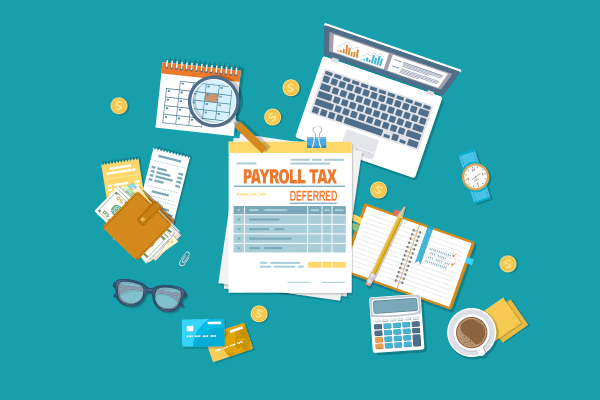Many American businesses are disregarding President Trump’s order allowing them to temporarily stop withholding Social Security taxes from their employees’ paychecks. The plan, they say, is confusing and won’t produce real savings for their companies or their workers.
Trump signed an executive order Aug. 8 that would allow employers to defer withholding most of what are called payroll taxes from employees earning less than $104,000 a year. The order affects earnings from Sept. 1 through the end of 2020.
There is a catch, though. The tax is deferred, not forgiven. You still owe it and it is due in full by the end of April 2021.
That means participating employees would owe double Social Security taxes between January and April to make up for taxes not withheld during the holiday. The other option would be to open a savings account and deposit the extra money from paychecks there so you could catch up in January.
Businesses can choose whether to participate, but federal employees – including members of the military – have no choice. Trump has ordered them in on the plan and they can’t get out. That means most will have their checks docked an extra 6.2% from January 2021 to April 2021 to make up for what they aren’t paying between now and Dec. 31 of this year.
Benefits of the Payroll Tax Deferral
The benefit of the payroll tax cut is that it puts more money in worker’s pockets each paycheck. Presumably, the workers will spend the extra cash and help revive the struggling COVID-19 economy. There has been talk that the uncollected tax will be forgiven at some point in 2021, assuming Trump wins re-election. However, that would have to be approved by Congress, which is not likely since neither the Senate nor the House of Representatives support the idea.
The 12.4% payroll tax is levied on earnings of as much as $137,700 in 2020. Employers and employees split the bill, so each pays 6.2%. Under the CARES Act that Trump signed last spring, employers received a reprieve from paying their part of the tax. The August order extends the temporary relief to workers’ portion of the tax.
The order doesn’t require employers to stop withholding payroll taxes and many probably won’t. Any relief coming from the program would be temporary and employers would still have to figure out how the tax would be paid when it ends on Dec. 31.
Drawbacks of Deferring Payroll Taxes
Though Trump insists the tax holiday will put more money in workers’ pockets and stimulate the Covid-19-battered economy, critics say it potentially will create a problem next year when employees paychecks shrink to make up for the unpaid tax.
The order doesn’t specify how the deferred tax will be collected. Some, and perhaps many, employers might opt to continue withholding their employees’ payroll tax and then pay it to the Internal Revenue Service at the end of the year.
Still more questions remain unanswered. Some in Congress have suggested that Trump overstepped his Constitutional authority is creating the tax holiday and they might seek to block it. It is also unclear what would happen to employees who left their jobs before the tax is paid. Perhaps their former employer would be liable to pay the tax on their departed employees’ behalf or the employees would have to pay it through their Form 1040 income tax return.
Thus far the U.S. Treasury Department hasn’t offered guidance on these issues, and employees of businesses that stopped withholding the tax face uncertainties. Will their employers hit them with a big income withholding at the end of the year or spread out increased withholdings in early 2021? The procedure hasn’t been clarified yet, though in late August Bloomberg News reported that the White House wants to hold employers, not employees, responsible for paying the tax when it comes due next year.
Since the tax holiday amounts to an interest-free loan and not a tax break, it’s unclear how much it will stimulate the economy. Some employees receiving the deferral might spend more now. If employees spend the money and don’t budget for the possible coming tax bill, they might face a financial hardship in 2021. Again, it remains unclear whether the employer or the employee will be responsible for paying the IRS.
In August, the U.S. Chamber of Commerce called the plan “unworkable” and sent Congressional leaders a letter slamming the order.
“Many of our members consider it unfair to employees to make a decision that would force a big tax bill on them next year,” the letter from members said. “Therefore, many of our members will likely decline to implement the deferral, choosing instead to withhold and remit to the government payroll taxes required by law.”
Employees might get to choose how to pay their deferred taxes. It’s possible they might pay it in a lump sum at the end of the year or their employers might spread it out through extra withholdings in 2021. Either way, the employees of businesses deferring payroll taxes ought to budget for an increased tax bill or less income in early 2021. Putting the extra income that results from the withholding moratorium in a bank account might be the wisest move.
Another concern has nothing to do with business and personal finance. The deferred money temporarily cuts revenue to the Social Security trust fund, the government reserve used to pay retirement benefits to tens of millions of Americans. Trump’s payroll tax deferral order shouldn’t stop Social Security funding, only delay it. But Trump has said he would like Congress to enact a permanent payroll tax cut. If that happened, the already withering Social Security trust fund could suffer a devastating blow that would undermine income for vast numbers of retirees.
Sources:
- Rosenberg, J. (2020, September 5) Thanks, but No. Small Business Shun Payroll Tax Deferral. Retrieved from https://apnews.com/1c12bd77a806850c3646c0e60500ebe7
- Davidson, L, et. al. (2020. August 27) White House Dissatisfaction Slows IRS Payroll Tax Guidance. Retrieved from https://www.bloomberg.com/news/articles/2020-08-27/white-house-holding-up-guidance-on-trump-s-payroll-tax-deferral
- Singletary, M. (2020, September 8) The President’s Payroll Tax Cut is really a Loan That Workers Have to Pay Back. Let’s Call It What It Is. Retrieved from https://www.washingtonpost.com/business/2020/09/08/trump-payroll-tax-holiday/
- Rowan, L. (2020, September 1) Trump’s Payroll Tax Holiday Starts Today: How Does It Work? Retrieved from https://www.forbes.com/sites/advisor/2020/09/01/trumps-payroll-tax-holiday-starts-today-how-does-it-work/#4a4761fd5e29
- Luhby, T. (2020, August 8) Coronavirus Has Already Dealt a Blow to Social Security’s Finances. Trump’s Payroll Tax Holiday Could Make It Worse. Retrieved from https://www.cnn.com/2020/08/07/politics/social-security-medicare-trump-payroll-taxes/index.html


















